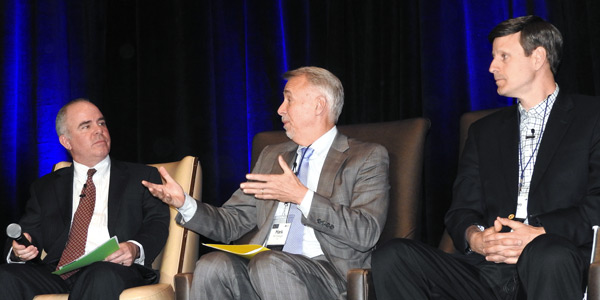By Rory D. Sweeney
PHILADELPHIA — PJM’s Grid 20/20 conference last week on grid reliability and fuel diversity left room for discussing all generation sources, but the conversation kept finding its way back to the natural gas pipeline system.
Jackie Roberts, the director of the West Virginia Consumer Advocate Division, started it off with a big proposal.
“It’s time for FERC to have someone regulate the pipeline build in the most efficient manner and make sure they’re built where they need to be built, not unlike transmission planning in PJM,” she said on the first of three panels throughout the day. “This needs to be resident in an expanded RTO or ISO. You know the problems we have with dealing with other RTOs. Imagine if we’re dealing with a different industry. It’s just unnecessary to have those complexities, so I’m proposing [a] PJM division that would do for the gas industry what it does for the electric industry.
“If I had a Ferrari in a race, I really wouldn’t want the fuel to be brought to me in the pit by the fuel barrel. I would want to know it was there and it was sufficient and it was being used as best it could be,” she added.
‘Premature’
Glen Thomas, president of the PJM Power Providers Group and GT Power Group, said such a sweeping change is “premature,” but the electricity industry needs to better understand the supply chain of one of its most critical inputs.
“The big message is we all [have] to get a little smarter about gas and understand the industry better than we currently do,” he said.
Mark McCullough, American Electric Power’s executive vice president for generation, pointed out an imbalance. Generation owners know even the smallest details of their units, he said, but “then you think about what’s happening on the other of the gas valve and wonder if those same kind of delivery approaches are taking place that brings that critical fuel to the asset that you’re spending so much time [on] making sure everything else works.”
That question isn’t unique to PJM, where a third of power is supplied by gas. Jeff Weathers, Southern Co.’s resource planning manager, said his company maintains a predominantly gas-fired generation fleet and performs an annual analysis of how the company could respond to potential pipeline failures.
Robert Kott, CAISO’s operations policy manager for regional operations policy and analytics, said 54% of California’s generation fleet is gas. He noted that a leak at the critical Aliso Canyon gas storage facility last year forced the ISO to adjust its market to reflect pipeline constraints. (See FERC OKs One-Year Extension for CAISO’s Aliso Canyon Gas Rules.)
Cara Lewis, Public Service Enterprise Group’s associate general regulatory counsel, said “heavy reliance on one fuel source negatively impacts resiliency and is not good for consumers.” She pointed to a pipeline explosion in Pennsylvania in April 2016 that created supply constraints in the Mid-Atlantic region.
“Our analysis shows that if this had happened in winter, we would have had to interrupt our electric-gas generation in order to fully supply our heating demand,” she said. “The choice for our customers would have been heat or light, but not both.”
Jurisdiction
Part of the issue is who is in charge of what. Joseph McClelland, the director of FERC’s Office of Energy Infrastructure Security, stressed that his office doesn’t set standards and regulations, only assesses their implementation and makes recommendations to the commission and other federal agencies. The Department of Energy coordinates the entire energy sector, he said, and the Department of Homeland Security and Transportation Security Administration set standards for pipeline cybersecurity, while the U.S. Coast Guard does so for LNG terminals.
McClelland echoed Thomas’ comments that the electricity industry needs to do more to understand the natural gas supply system. He said gas-fired generators need to consider “what sort of contractual obligations do [pipelines] have? What’s their security posture? And what’s your recovery plan if the gas pipeline is lost?”
“The good news is in terms of how we built out the grid, it’s incredibly efficient, it’s economically effective, it’s highly reliable — but it’s also more heavily interconnected than it’s been at any given point in time in the history of the grid,” PJM’s Jonathon Monken said. “That’s why this conversation is timely and relevant because we need to look at those interdependencies in a different way.”
PJM CEO Andy Ott addressed the topic with his opening remarks, saying one of the RTO’s current questions is whether it’s recognizing the operational risk of a pipeline disruption. “Instead of worrying and saying, ‘Are we sure we’re secure?’ I think defining the problem and looking toward defining solutions is the way to go,” he said.
The Natural Gas Supply Association, which had a representative in attendance, did not respond to requests for comment.






